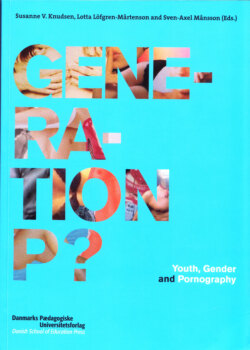Читать книгу Generation P? - Группа авторов - Страница 18
На сайте Литреса книга снята с продажи.
Sex as narrative and manual
ОглавлениеIn The Transformation of Intimacy, Giddens discusses the changes people’s intimate relationships have undergone during modernity (Giddens 1992). Contemporary love relations are increasingly characterized by openness. The forms of relations and sexuality are not given in advance, but are instead open to negotiations, shifts and sometimes even dramatic transformations. These transformations place greater demands on people to keep up-to-date and to read the latest manuals with advice on how they should cultivate their love and sex lives (Hawkes 1996).
These new ‘manuals’ need not always be in book form, but may just as well be in the form of soap operas, magazines or even pornography. According to Löfgren-Mårtenson & Månsson (2006) and Sørensen (2006), young people use pornography in order to learn about sexual practice and explore new understandings of their gender, body and sexuality. Aagre (2006) claims in a quite similar way that youth consume pornographic material as a kind of “enlightenment-project” in order to cultivate new understandings and reflexive positions. For example, one girl in Aagre’s study says that she consumes porn to get a picture of her male friends’ sexual references. She then uses this knowledge to enlighten her male friends and insure that they do not get a “wrong” picture of sexuality. Pornography therefore seems to interact with young peoples’ understandings of sexuality and bring questions of a reflexive sexuality to the fore.
The duplicity that characterizes all attempts to define, categorize, study, present and give shape to sexuality is something that contemporary humankind must live with. Yet one must ask, when is this a matter of repression and when is it a matter of freedom, desire and the open acknowledgment of sexuality? The duplicity that Foucault once pointed out would appear to be something we must learn to live with (Weeks 1985). We may ask ourselves whether everyday life and people in general have developed in the direction of what Giddens calls pure relations. Or, we may ask whether sexual experimentation, adventure, full expression and the “worry-free” life – that is, everything that would seem to characterize post-modern life – have also to increasingly greater degrees marked the sexuality of contemporary humankind? Is it not still the case that sexuality is surrounded by sexual taboos, boundaries, morals and other directives and that normative intercourse still seems to be heterosexual, domestic, monogamous, voluntary, non-commercial and reproductive (Rubin 1998 [1984])? When Bauman describes his post-modern sexuality, it is precisely sexuality free from responsibility that he stresses.
Eroticism cut free from its reproductive and amorous constraints fits the bill very well; it is as if it were made to measure for the multiple, flexible, evanescent identities of postmodern men and women. Sex free of reproductive consequences and stubborn, lingering love attachments can be securely enclosed in the frame of an episode, as it will engrave no deep grooves on the constantly re-groomed face being thus insured against limiting the freedom of further experimentation (Bauman 1999, 27).
We can compare this picture to that presented by Ken Plummer in a number of texts on the reflexive and ethical individual (Plummer 1995, 1996). Choosing and recognizing one’s own freedom – in some sense – is not necessarily the same as developing an inconsiderate attitude.
What we touch upon is a theme connected to the idea of a post-emotional society – a society in which emotional life has become increasingly undermined, affected, outstripped and ‘media-ized’ (Mestrovic 1997). We no longer see the fascination with confession that Foucault discusses, but have instead developed a blasé attitude. Yet people still continue to confess and tell their sexual stories. Interpreting these stories has become increasingly difficult. According to Plummer, people find the inspiration and models for their storytelling in the media and in the culture (Simmel 1995). There are, therefore, no true narratives, only narratives. Could it be the case that this telling has become somewhat mechanical – that narratives come nowhere near any form of authenticity?
If sex has become more and more calculated – something used instrumentally or perhaps something interconnected with the imaginary and with the media images we are fed on a daily basis – then a shift from everyday life to the simulated world has taken place. If everything that reminds us of ‘the natural’ – for example bodily secretions and odors – is experienced as strange, as something that must be eliminated, where does that leave us? Perhaps, in the end, people will limit themselves entirely to telephone sex instead of physical sex and to relationships on the Internet rather than in a problem-filled reality (Kroker & Kroker 1988). Indeed, it seems that some people have done that already.
